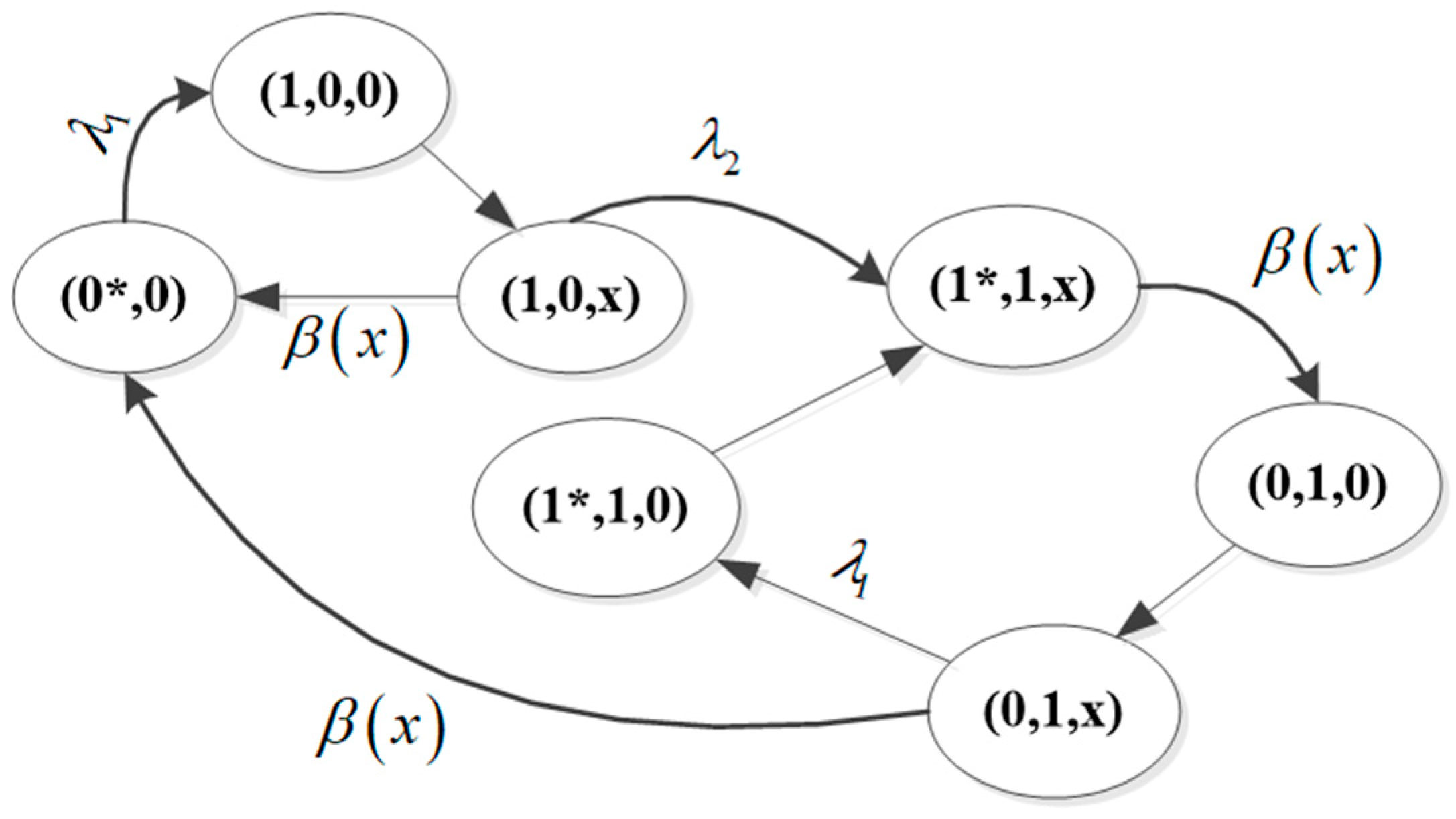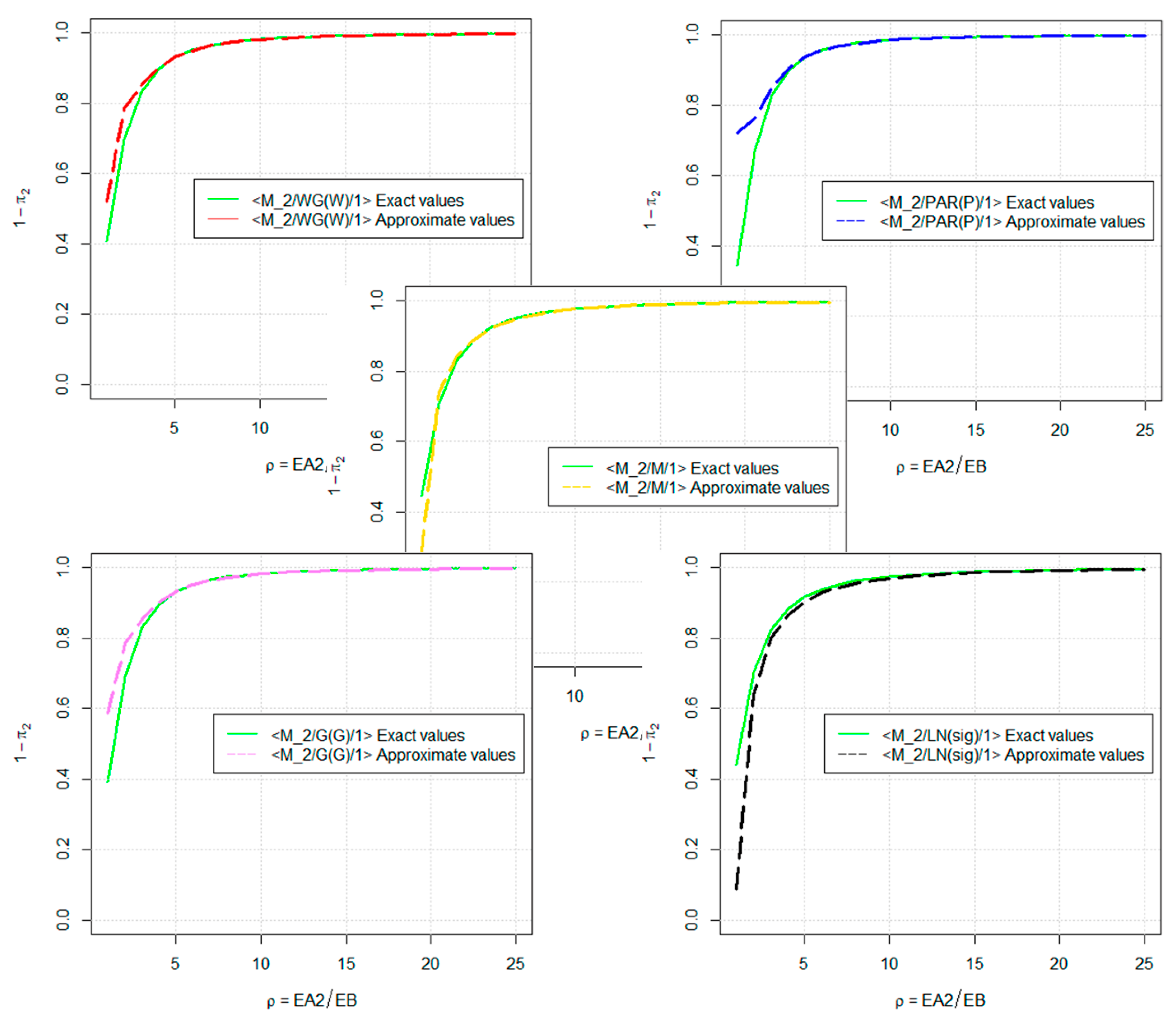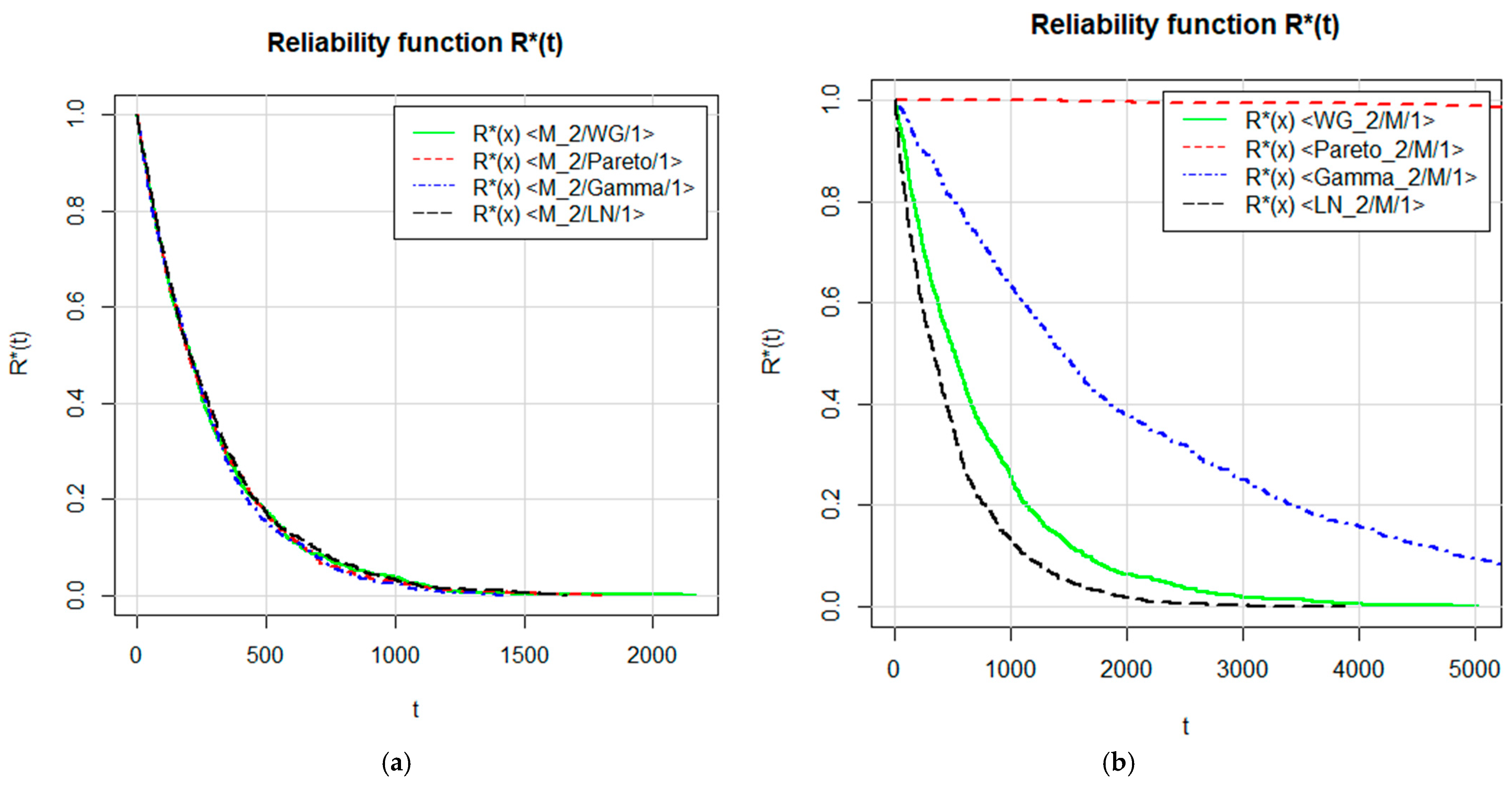Mathematical and Simulation Model for Reliability Analysis of a Heterogeneous Redundant Data Transmission System †
Abstract
:1. Introduction
- CDF—cumulative distribution function.
- PDF—probability density function.
- LT—Laplace transform.
- MTTF—mean time to failure.
- RRR—relative recovery rate.
- r.v.—random variable.
- —r.v., time to failure of the main component, i = 1, 2.
- B—r.v., recovery time of a failed component.
- —CDF of the r.v. ;
- B(x)—CDF of the r.v. B.
- b(x)—PDF of the r.v. B.
- —LT of the PDF b(x).
- —mean uptime of a working component, i = 1, 2.
- EB—mean repair time of a failed component.
- ET—mean time to failure of the system.
- —RRR.
- —conditional PDF relative to the time spent on completion of the repair [19].
- λi—parameter of the exponential distribution of the uptime of components, i = 1, 2.
- —estimate of the system’s operating time until failure.
2. Background and Motivation
3. Mathematical Model: Assumptions, Notations, Problem Setting
4. Asymptotic Expression for the Steady-State Probabilities of the System under Rare System Failures
5. Simulation Model for the Analysis of System-Level Reliability
5.1. Simulation Model for Assessing the System’s Steady-State Probabilities
| Algorithm 1. Simulation model for assessing steady-state probabilities of the system <GI2/GI/1> |
| Initial data: A—r.v. of the failure time; B—r.v. of the recovery time; N = 2—number of system’s elements; —time to failure of elements; —moment of element’s failure in system η—time to repair of the failed element; tcur—current time; i0; i1; i2—number of failed elements; T—maximum model run time. Input: a1, a2, b1, N, T, NG, GI. a1—mean time to failure of first (main) element (FSO), a2—mean time to failure of the second element (RF), b1—mean time to repair, N—number of elements in the system, NG—number of trajectories graphs, T—maximum model run time, GI—general independent distribution function. Output: steady-state probabilities . |
5.2. Simulation Model for Assessing the System Reliability
| Algorithm 2. Simulation model for assessing the system reliability |
| Input: a1, a2, b1, N, NG, GI. Output: Assessed value of the MTTF . |
6. Numerical and Graphical Results of the Mathematical and Simulation Model
7. Discussion
8. Conclusions
Author Contributions
Funding
Institutional Review Board Statement
Informed Consent Statement
Acknowledgments
Conflicts of Interest
Appendix A
| Algorithm A1. The simulation pseudocode for the system <GI2/GI/1> |
| Begin array r[]: = [0,0,0]; / / multi-dimensional array containing results, k-step of the main cycle double t: = 0.0; // time clock initialization int i: = 0; j: =0; // system state variables double tnextfail: = 0.0; // variable in which time until the next element failure is stored double tnextrepair: = 0.0; // variable in which time is stored until the next repair is completed int k: = 1; // counter of iterations of the main loop s[]: = rf_GI(1,λi ); // generation of an arbitrary random vector s- time to the first event (failure) sr[]: = rf_GI(1,β(x)); // generation of an arbitrary random variable sr-time of repair of the failed element) while t < ∞ do if i == 0 then s[i + 1]: = rf_GI(1,λ(i+1) ); tnextrepair: = ∞; j: = j + 1;t: = t_nextfail; end else i == 1 then else if (i − 1) == 0 then s[i + 1]: = rf_GI(1,λ(i+1)); sr[i]: = rf_GI(1,”β(x)”); tnextfail: = t + s[i + 1]; tnextrepair: = t + sr[i]; if tnextfail < tnextrepair then j: = j + 1; t: = tnextfail; else j: = j−1; t: = tnextrepair; end else if (i − 1) == N then s[i + 1]: = rf_GI(1,λ(i)); sr[i + 1]: = rf_GI(1,”β(x)”); tnextfail: = t + s[i + 1]; tnextrepair: = t + sr[i + 1]; if tnextfail < tnextrepair then j: = j + 1; t: = tnextfail; else j: = j−1; t: = tnextrepair; end end else i == N then tnextfail: = ∞; j: = j − 1; t: = tnextrepair; end if t > T then t = T end r[,,k]: = [t,i,j]; i: = j; k: = k + 1; end do Calculate estimated sojourn time in each state i, (i = 0,1,2). Stationary probabilities are calculated as: End |
Appendix B
| Algorithm A2. The simulation pseudocode for the system <GI2/GI/1> |
| Begin array r[]: = [0,0,0]; int i: = 0; int j: = 0; double tnextfail: = 0.0; double tnextrepair: = 0.0; double t: = 0.0; int k: = 1; s[]: =rf_GI(1,λi); sr: = rf_GI(1,β(x)); while t <∞ do if i == 0 then s[i + 1]: = rf_GI(1,λ(i+1)); tnextrepair: =∞; j: = j + 1;t: = t_nextfail; end else i == 1 then s[i + 1]: = rf_GI(1,λ(i+1)); sr[i]: = rf_GI(1,”β(x)”); tnextfail: = t + s[i + 1]; tnextrepair: = t + sr[i]; if tnextfail < tnextrepair then j: = j + 1; t: = tnextfail ; else j: = j − 1; t: = tnextrepair; end end else i == N thenBreak; end r[,,k]: = [t,i,j]; i: = j; k: = k + 1; end do Calculate estimated sojourn time in state N. Estimate of the MTTF of the systemis: End |
References
- Rykov, V.V.; Kozyrev, D.V. On sensitivity of steady-state probabilities of a cold redundant system to the shapes of life and repair time distributions of its elements. Springer Proc. Math. Stat. 2018, 231, 391–402. [Google Scholar] [CrossRef]
- Houankpo, H.G.K.; Kozyrev, D.V.; Nibasumba, E.; Mouale, M.N.B.; Sergeeva, I.A. A Simulation Approach to Reliability Assessment of a Redundant System with Arbitrary Input Distributions. LNCS 2020, 12563, 380–392. [Google Scholar] [CrossRef]
- Houankpo, H.G.K.; Kozyrev, D.V. Reliability Model of a Homogeneous Warm-Standby Data Transmission System with General Repair Time Distribution. LNCS 2019, 11965, 443–454. [Google Scholar] [CrossRef]
- Houankpo, H.G.K.; Kozyrev, D.V.; Nibasumba, E.; Mouale, M.N.B. Reliability Analysis of a Homogeneous Hot Standby Data Transmission System. In Proceedings of the 30th European Safety and Reliability Conference and 15th Probabilistic Safety Assessment and Management Conference (ESREL2020 PSAM15), Venice, Italy, 1–5 November 2020; pp. 1–8. [Google Scholar]
- Houankpo, H.G.K.; Kozyrev, D.V. Sensitivity Analysis of Steady State Reliability Characteristics of a Repairable Cold Standby Data Transmission System to the Shapes of Lifetime and Repair Time Distributions of Its Elements. In Proceedings of the Information and Telecommunication Technologies and Mathematical Modeling of High-Tech Systems, Moscow, Russia, 24 April 2017; Volume 1995, pp. 107–113. Available online: http://ceur-ws.org/Vol-1995/paper-15-970.pdf (accessed on 1 August 2021).
- Sijia, L.; Yuyu, W.; Zhaocai, L. Reliability analysis of general systems with bi-uncertain variables. Soft Comput. 2019, 24, 6975–6986. [Google Scholar] [CrossRef]
- Gen, Q.X.; Yan, L.L. Analysis of two components parallel repairable system with vacation. Commun. Stat.-Theory Methods 2019, 50, 2429–2450. [Google Scholar] [CrossRef]
- Xin, G.; Jiali, S.; Qingtai, W. Reliability analysis for a cold standby system under stepwise Poisson shocks. J. Control. Decis. 2021, 8, 27–40. [Google Scholar] [CrossRef]
- Liu, Y.; Qu, Z.; Li, X.; An, Y.; Yin, W. Reliability Modelling for Repairable Systems with Stochastic Lifetimes and Uncertain Repair Times. IEEE Trans. Fuzzy Syst. 2019, 27, 2396–2405. [Google Scholar] [CrossRef]
- Liu, Y.; Ma, Y.; Qu, Z.; Li, X. Reliability Mathematical Models of Repairable Systems with Uncertain Lifetimes and Repair Times. IEEE Access 2018, 6, 71285–71295. [Google Scholar] [CrossRef]
- Li, J.; Chen, Y.; Zhang, Y.; Huang, H. Availability modeling for periodically inspection system with different lifetime and repair-time distribution. Chin. J. Aeronaut. 2019, 32, 1667–1672. [Google Scholar] [CrossRef]
- Liu, B.; Qin, F.; Liu, S.; Cai, S. Reliability Modeling with Application for Calibration Data. In Proceeding of the 24th International Conference on Industrial Engineering and Engineering Management, Changsha, China, 19–20 May 2018; Springer: Singapore, 2019; pp. 133–141. [Google Scholar] [CrossRef]
- Al Turk, L.I. Characteristics and Application of the NHPP Log-Logistic Reliability Model. Int. J. Stat. Probab. 2019, 8, 44–55. [Google Scholar] [CrossRef]
- Wang, C.; Xing, L.; Peng, R. Approximate reliability analysis of large heterogeneous cold-standby systems. In Proceedings of the International Conference on Quality, Reliability, Risk, Maintenance and Safety Engineering (QR2MSE 2014), Dalian, China, 22–25 July 2014. [Google Scholar] [CrossRef]
- Abbas, B.; Javad, B.; Tore, M. Application of reliability models with covariates in spare part prediction and optimization—A case study. Reliab. Eng. Syst. Saf. 2014, 123, 1–7. [Google Scholar] [CrossRef]
- Khorshidian, K.; Fathizadeh, M. An Alternative Approach to Reliability Analysis of Cold Standby Systems. Commun. Stat.-Theory Methods 2015, 45, 6471–6480. [Google Scholar] [CrossRef]
- Parshutina, S.; Bogatyrev, V. Models to support design of highly reliable distributed computer systems with redundant processes of data transmission and handling. In Proceedings of the International Conference “Quality Management, Transport and Information Security, Information Technologies (IT&QM&IS)”, St. Petersburg, Russia, 24–30 September 2017. [Google Scholar] [CrossRef]
- The, J.; Lai, C.-M.; Cheng, Y.-H. Impact of the real-time thermal loading on the bulk electric system reliability. IEEE Trans. Reliab. 2017, 66, 1110–1119. [Google Scholar] [CrossRef]
- Lisnianski, A.; Laredo, D.; Haim, H.B. Multi-state Markov model for reliability analysis of a combined cycle gas turbine power plant. In Proceedings of the Second International Symposium on Stochastic Models in Reliability Engineering, Life Science and Operations Management (SMRLO), Beer Sheva, Israel, 15–18 February 2016. [Google Scholar] [CrossRef]
- Xu, J.J.; Xiao, Z.J. Reliability Analysis of Cold Standby Compound System. Adv. Mater. Res. 2014, 945–949, 1116–1119. [Google Scholar] [CrossRef]
- Qingtai, W. Reliability analysis of a cold standby system attacked by shocks. Appl. Math. Comput. 2012, 218, 11654–11673. [Google Scholar] [CrossRef]
- Vanderperre, E.J. Reliability analysis of a renewable multiple cold standby system. Oper. Res. Lett. 2004, 32, 288–292. [Google Scholar] [CrossRef]
- Houankpo, H.G.K.; Kozyrev, D.V.; Nibasumba, E.; Mouale, M.N.B. Mathematical Model for Reliability Analysis of a Heterogeneous Redundant Data Transmission System. In Proceedings of the 12th International Congress on Ultra-Modern Telecommunications and Control Systems and Workshops (ICUMT 2020), Brno, Czech Republic, 5–7 October 2020; pp. 189–194. [Google Scholar] [CrossRef]
- Kala, Z. Sensitivity analysis in probabilistic structural design: A comparison of selected techniques. Sustainability 2020, 12, 4788. [Google Scholar] [CrossRef]
- Letzepis, N.; Fàbregas, A. Hybrid RF/FSO communications. In Advanced Optical Wireless Communication Systems; Cambridge University Press: Cambridge, UK, 2012; pp. 273–302. [Google Scholar] [CrossRef]
- Kendall, D.G. Stochastic processes occurring in the theory of queues and their analysis by the method of embedded Markov chains. Ann. Math. Stat. 1953, 24, 338–354. [Google Scholar] [CrossRef]
- Sevastyanov, B.A. An Ergodic theorem for Markov processes and its application to telephone systems with refusals. Theor. Probab. Appl. 1957, 2, 104–112. [Google Scholar] [CrossRef]
- Petrovsky, I.G. Lectures on the Theory of Ordinary Differential Equations (Lektsii po Teorii Obyknovennykh Differentsialnykh Uravneniy); GITTL: Moscow, Russia, 1952; pp. 1–232. (In Russian) [Google Scholar]






| P0 | P1 | P2 | ||
|---|---|---|---|---|
| <M2/WG/1> | S | 0.9578 | 0.0393 | 0.0029 |
| E | 0.9579 | 0.0393 | 0.0028 | |
| A | 0.9580 | 0.0391 | 0.0029 | |
| <WG2/M/1> | S | 0.9603 | 0.0384 | 0.0014 |
| <M2/PAR/1> | S | 0.9577 | 0.0402 | 0.0021 |
| E | 0.9578 | 0.0401 | 0.0021 | |
| A | 0.9579 | 0.0400 | 0.0021 | |
| <PAR2/M/1> | S | 0.961545 | 0.038452 | 3 · 10−6 |
| <M2/G/1> | S | 0.9577 | 0.0396 | 0.0027 |
| E | 0.9579 | 0.0395 | 0.0026 | |
| A | 0.9579 | 0.0394 | 0.0027 | |
| <G2/M/1> | S | 0.9611 | 0.0385 | 0.0005 |
| <M2/LN/1> | S | 0.9579 | 0.0374 | 0.0047 |
| E | 0.9582 | 0.0374 | 0.0044 | |
| A | 0.9583 | 0.0364 | 0.0053 | |
| <LN2/M/1> | S | 0.9594 | 0.0384 | 0.0022 |
| <M2/WG/1> | 466.5521 |
| <WG2/M/1> | 802.1117 |
| <M2/PAR/1> | 271.7611 |
| <PAR2/M/1> | 319260.8 |
| <M2/G/1> | 280.5388 |
| <G2/M/1> | 2114.169 |
| <M2/LN/1> | 308.1753 |
| <LN2/M/1> | 483.4727 |
| GI | WG | PAR | G | LN |
|---|---|---|---|---|
| Re | 87 | 996 | 533 | 24 |
Publisher’s Note: MDPI stays neutral with regard to jurisdictional claims in published maps and institutional affiliations. |
© 2021 by the authors. Licensee MDPI, Basel, Switzerland. This article is an open access article distributed under the terms and conditions of the Creative Commons Attribution (CC BY) license (https://creativecommons.org/licenses/by/4.0/).
Share and Cite
Houankpo, H.G.K.; Kozyrev, D. Mathematical and Simulation Model for Reliability Analysis of a Heterogeneous Redundant Data Transmission System. Mathematics 2021, 9, 2884. https://doi.org/10.3390/math9222884
Houankpo HGK, Kozyrev D. Mathematical and Simulation Model for Reliability Analysis of a Heterogeneous Redundant Data Transmission System. Mathematics. 2021; 9(22):2884. https://doi.org/10.3390/math9222884
Chicago/Turabian StyleHouankpo, Hector Gibson Kinmanhon, and Dmitry Kozyrev. 2021. "Mathematical and Simulation Model for Reliability Analysis of a Heterogeneous Redundant Data Transmission System" Mathematics 9, no. 22: 2884. https://doi.org/10.3390/math9222884
APA StyleHouankpo, H. G. K., & Kozyrev, D. (2021). Mathematical and Simulation Model for Reliability Analysis of a Heterogeneous Redundant Data Transmission System. Mathematics, 9(22), 2884. https://doi.org/10.3390/math9222884






